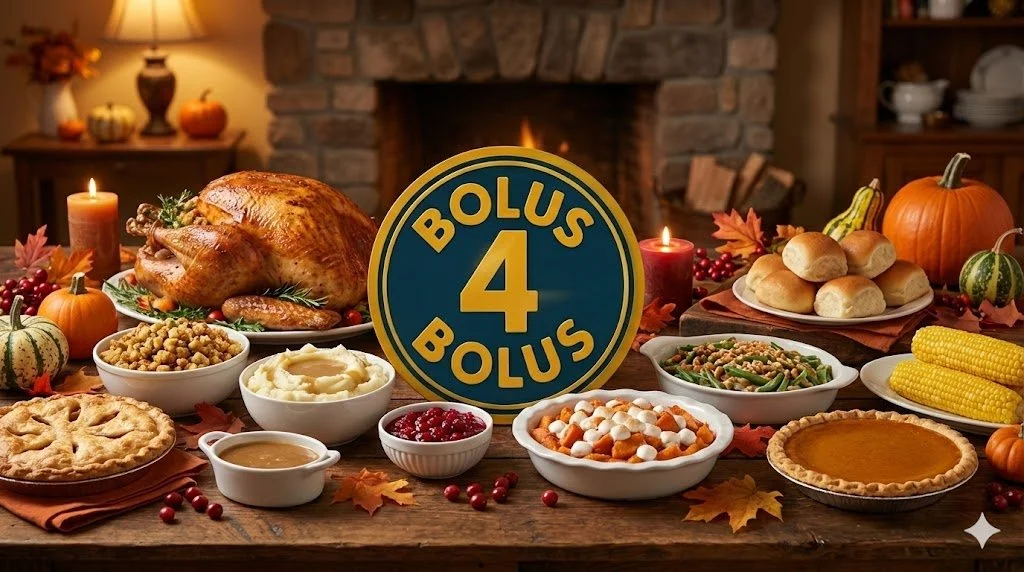#1656 Bolus 4 - Little Bites
You can always listen to the Juicebox Podcast here but the cool kids use: Apple Podcasts/iOS - Spotify - Amazon Music - Google Play/Android - iHeart Radio - Radio Public, Amazon Alexa or wherever they get audio.
Jenny and Scott talk about bolusing for Little Bites chocolate chip muffins.
+ Click for EPISODE TRANSCRIPT
DISCLAIMER: This text is the output of AI based transcribing from an audio recording. Although the transcription is largely accurate, in some cases it is incomplete or inaccurate due to inaudible passages or transcription errors and should not be treated as an authoritative record. Nothing that you read here constitutes advice medical or otherwise. Always consult with a healthcare professional before making changes to a healthcare plan.
Scott Benner 0:00
Hello friends and welcome back to another episode of The Juicebox podcast.
In every episode of Bolus for Jenny Smith and I are going to take a few minutes to talk through how to Bolus for a single item of food. Jenny and I are going to follow a little bit of a roadmap called meal bolt. Measure the meal, evaluate yourself, add the base units, layer a correction. Build the Bolus shape, offset the timing. Look at the CGM. Tweak for next time. Having said that these episodes are going to be very conversational and not incredibly technical. We want you to hear how we think about it, but we also would like you to know that this is kind of the pathway we're considering while we're talking about it. So while you might not hear us say every letter of meal bolt in every episode, we will be thinking about it while we're talking. If you want to learn more. Go to Juicebox podcast.com. Forward, slash, meal, dash, bolt. But for now, we'll find out how to Bolus for today's subject,
nothing you hear on the Juicebox podcast should be considered advice medical or otherwise, always consult a physician before making any changes to your health care plan. Jenny, we are going to jump into our Bolus for today. Yay, with one that I will admit got me when Arden was first diagnosed, and is a food that I no longer will let my children eat. But, and I think it's diabetes that showed me that this is not a thing we should be eating. Do you know a little something called little bites, chocolate chip muffins?
Jennifer Smith, CDE 1:47
I do. Are they? They're not a Little Debbie product? Are they
Scott Benner 1:50
made by a company called entamins? Oh, and
Jennifer Smith, CDE 1:52
Tim, oh, I Well, I know entamins Definitely. They're the, they're the package thing that looks like, even after the apocalypse, they probably wouldn't be moldy in the box at the grocery store,
Scott Benner 2:02
right? There's something to it, because a pouch of little bites chocolate chip muffins, which I think, I mean, if I'm going off of how they got used in my house, it's, you know, from mornings when you got up late and the kids would grab them and go to the bus with them, or something like that, right? Okay? And to say that the muffins are maybe, I don't know, like maybe an inch and three quarters across and maybe that high. They're not big. Sure you ran, I think you get five, usually in a bag, but once in a while you only get four. You get six. It's a crazy day. You've gotten super lucky, and there's six in there. But let's just go with the five. I'm looking at the label right here. So at calories, 190 calories for the pouch, okay, nine total grams of fat, not so bad. There's a lot of cholesterol in them. That's interesting. 20 milligrams of cholesterol, 150 milligrams of sodium. Total sugars, 17, added sugar, 17 total carbohydrates, 27
Jennifer Smith, CDE 3:03
and what? What's half of 27 it's half of 27 it's,
Scott Benner 3:09
let's see 10, like 13 and a half, or something like that.
Jennifer Smith, CDE 3:13
Do you know why I'm asking this? I have no idea. I'm asking it because 17 grams of total sugar means that more than 50% of these muffins
Scott Benner 3:23
is sugar. Oh, yeah. I don't know what a muffin is, but it's not it's not that,
Speaker 1 3:27
like these are Sugar Bombs in a
Scott Benner 3:31
package. I want to point out that if this Smart Label website that I'm on is correct, that these are manufactured by bimbo bakeries for intimacy. If that's correct, are they trolling us? Is that what's happening exactly? Yeah. So if I, if I switch over to the ingredients label, the first thing on the ingredients label is, in fact, sugar, then it is white flour. So those are your tops, sugar and white flour. Anyway, let's go to our our steps. Is there any protein? Yes, like a gram, I think it's two protein, two, two grams of protein, no vitamin D. There is some added calcium, iron and potassium. Okay, fortified isn't my new favorite word is, we're doing this. It's been fortified,
Jennifer Smith, CDE 4:23
fortified and enriched. Yes, they're both right.
Scott Benner 4:27
It makes it sound like they've lined a bunch of army people around our castle to fortify it. We're going to be safe because we fortified your mother for you. Don't you worry. Everything's going to be fine. Now here's the real interesting thing about little bites muffins, from my perspective and from the perspective of everybody who wrote in about little bites muffins I have, I didn't realize they were such a thing. They are so high on my list, and my list is set up by how many people brought them up. So wow, yes, they are only below here. This will give you some context. They are only below pancakes. Pop Tarts, French toast, Costco muffins, cinnamon rolls from Cinnabon. Oh, I haven't had a Cinnabon in a long time. Toaster, strudel oatmeal cereal. That's the only thing that's above it on the list, so, but here, somebody actually sent in a little vignette about them, and I'm gonna read it, please. She eats them almost every morning. We're MDI. We Pre-Bolus 45 minutes. If we give her a half a unit more, she crashes hard. We've played around with the Pre-Bolus too. And no matter what, she goes to 230 and comes back down. Then this person came back, commented again, 25 weeks later, because I've been pulling this information together for like, a year. Okay? So I know people are like, Oh, I didn't realize he was actually planning any of this out. So 25 weeks later, she came back and said, We figured them out. We pair it with a protein, like an egg or a breakfast meat. We Pre-Bolus 30 minutes. She eats the protein completely first, then the muffins. We also do four to six ounces of water during the Pre-Bolus to get her hydrated. She still goes to 160 or 170 but comes right back down. She used to sort of 250 or even 300 every single time we ate these muffins. And this person's like, Hey, we got this down now. And I really and thanks to the podcast. And actually they thank Omnipod five, and they're all happy. But that's a win. A win is, you know, yeah, yeah, it absolutely is. But at the same time, I mean, I'm in my mind, Jenny's going don't eat those muffins. I think that's the answer to this question. But, like, I know we don't have them in front of us, and we don't have a breakdown, but there's something about this specific food item, right? That just, it's like rocket fuel. I mean, a 45 minute pre bouls And she was still going
Jennifer Smith, CDE 6:46
to and again, kudos to this person, this family, honestly, for sticking with it and saying, Hey, I'm going to figure it out. I know there are a lot of there are a lot of kids who have choice kind of issues, sensory types of issues, that it is what it is, and you have to do the best that you honestly can. And while the parents were probably thinking, we could just change this, maybe it wasn't that easy. And despite it not being food that technically is providing quality nutrition, they have figured it out, utilizing all of the strategies that they have learned, which is 100% a win for them, they are now getting glucose levels that are much, much improved, right shorter. They're also not over bolusing to achieve the results, and probably along the lines of the A ID system, Omnipod, five. It sounds like they're using right? They've figured out by doing a lot of experimentation, how much do we have to give? What do we have to add to the picture? The proteins and the fats are huge, especially along the lines of starting with them first, so that it creates almost a slower digestion to get going, especially first thing in the morning, their body's breaking that down before you put in the sugar, which is what these are, right? I mean, you read the ingredients, you can't lie about it. They're more than 50% sugar by kind of carbohydrate count, but they've navigated smoothing that and again, on the back end, with the help of the A ID and their bolusing strategy and the way that they're putting their nutrients in, they figured it out.
Scott Benner 8:29
Yeah, no, I think it's awesome that they said to themselves, there are settings here and timing that will do will handle this. Yes, and they did it, which is awesome. So like, let's another thing to add to this, but let's go back here to our to our checklist, measure the meal we did that, evaluate yourself. You know, it's, she actually said it's the morning like, not as hydrated. She put some more water in. Yeah. You know, gonna come out and see, you know, is our blood sugar? 150 is it? 180 is it 70? You know, right? Keep that in the in the idea, when you're making your Bolus, calculate your food with this one here, using our one to 10, you know, example number that we're going to use every time in one of these episodes, just looking at like 2.7 units, right? You know, as
Jennifer Smith, CDE 9:13
long as your blood sugar is at Target or in that target, then there's no correction.
Scott Benner 9:17
And if not, we'll make a correction to that if there's more less needed. Now this is one of those where you're like, Well, how do I build the Bolus out? Is it? Is it extended? Like it's tough one because it hits so hard. I mean, obviously, look at the crazy Pre-Bolus. She needed just to sort of stay ahead of it. But if she were to make the Pre-Bolus that long and give a little too much insulin, there was a crash. So she gets that all figured out. It's a tough one for me. Like, I know it's a, it's a sugar spike, I wouldn't feel super comfortable layering, like extra basal or extended boluses over a sugar spike, because it's gonna, it's gonna crash the other way, right? And then, you know, take a look at your CGM an hour later, and, you know, make adjustments if you need to. And then a. Right? The thing she did, which is awesome, which was tweak it for next time
Jennifer Smith, CDE 10:03
well, and something that goes along with building that Bolus, especially for breakfast or the very first meal of the day that you're eating, this can definitely still be the case, even on an A ID system like Omnipod five, that you don't have control of your basal anyway. So it's not like they could really shift that, because it's right, it's an adapted give. But if they've had any mornings that this child has slept in or maybe didn't want breakfast, they probably had a good idea that without this meal, everything looked hunky dory, right? Everything was smooth in Target stable, there were no issues. So they knew that the Bolus and how they were adjusting for the components of the meal eventually, that was going to be what created the win.
Scott Benner 10:52
Let me ask you a question, because when this happened to me all those years ago, what I did was I started making chocolate chip muffins from scratch, and I just used, I didn't do something super healthy. I went to actually remembered what it was, and brought it up while we were talking King Arthur baking.com. So King Arthur makes flour, a lot of different flour, and they have some recipes on their site. So I found this, like they call it a golden chocolate chip muffin recipe. Now I'm gonna, I have the nutrition from that here to show you that it's not like some like, you know, grand experiment in good health, right? You get 12 muffins out of a batch. Now, a muffin is 95 grams, and with the little bites, the pouch was 47 grams. So, you know, it's twice as big. You don't have to eat the whole thing. But keeping that in mind, but there are 50 carbs in a 95 gram muffin made from this, you know, King Arthur recipe that I found, 17 grams of fat, way more cholesterol, you know, more sodium, 50 carbs, right? But it's butter, sugar, baking powder, salt, flour, eggs, milk, chocolate chips. That was it, right? And it did not hit Arden nearly as hard. So then I'm sure not, yeah, yeah. But, like, let's give people some understanding why. So I just read you the the ingredients of the muffins I made. That was, that's what's in them. The ingredients on the little bites are sugar, bleached wheat flour, water, soybean oil, chocolate chips. And it's easy to say, oh, good chocolate chips. Chocolate chips are sugar, chocolate liqueur, dextrose, coconut butter, soy lecithin, lecithin, vanilla extract. Now there's also in that eggs modified corn starch, dextrose, whey, fructose, glycerin, leavening agent, which would you know, like baking soda or baking powder, like that, artificial flavors, mono and big lysir rides. Do you know that one digly, CDE, glycerides, salt, sodium, sterile, lactate, sterile like lactate, potassium sorbate, which is a preservative, sorbitin, mono sorbet and mono saturate. Xyna, thin gum, poly sorbate, 60 cellulos, gum, soy lecithin, lecithin, whey protein concentrate. So somewhere in those words, is the reason, right? And it's mostly sugar, right?
Jennifer Smith, CDE 13:27
That is the major hit. It's the reason that it required initially, at least a 45 minute without even really great results with that right?
Scott Benner 13:36
Why does that hit harder and is more difficult to control than the one I made that has more sugar in it.
Jennifer Smith, CDE 13:41
It's the simplicity of the ingredients. And the question too, is your flour? And I know the King Arthur Flour brand, they have quite a number of quality types of flowers, my expectation is that you weren't getting a bleached flour.
Scott Benner 13:59
Yes, yeah, no, yeah. And I do, and I do that on purpose too, actually, now that the prices are all crazy, it doesn't matter anymore, but I did, you did spend, I think, a couple dollars more for a five pound bag back then, right? Yes, that was me trying to say, well, like, if we're gonna do this, like, at least, let's use as pure ingredients as possible, correct? Anyway, absolutely. Okay, so there you go for all you little bites fans, of which, like I said, God bless you. They're super easy to buy. They're super easy to give to the kids in the morning. And you know what? It's funny on the label, I just want to say it says, made with real chocolate. There's no artificial colors in it. And this one's like, actually surprised me because of how hard they had no high fructose corn syrup. So what happened there? Yeah, well, they used sugar instead, there instead,
Jennifer Smith, CDE 14:50
which, you know, great again. But I think the biggest hitter that this family found was that, and it's much like the glucose goddess talks about. And I. Taught years before I even know who she was. Right? It's if you start a meal with some proteins, proteins and fats, you get a much slower glycemic hit from the carbs that you do eat. Now, the nature of the carbs makes a difference as well, which we've talked about. But if it's going to be a carbohydrate like this one in particular. Definitely help yourself by adding something in that's providing a stabilizing base.
Scott Benner 15:29
Awesome. Okay, I appreciate it. This is, I mean, this is going to be a good one. People love this, these chocolate chip mops. I also want to say I thought they were good too. That's all. Bye, you.
In each episode of The Bolus four series, Jenny Smith and I are going to pick one food and talk through the Bolus thing for that food, we hope you find it valuable. Generally speaking, we're going to follow a bit of a formula, the meal bolt formula, M, E, A, l, B, O, L, T. You can learn more about it at Juicebox podcast.com, forward slash, meal, dash, bolt. But here's what it is, step 1m. Measure the meal E, evaluate yourself. A, add the base units, l, layer a, correction B, build the Bolus shape, O, offset the timing. L, look at the CGM and T, tweak for next time. In a nutshell, we measure our meal, total carbohydrates, protein, fat, consider the glycemic index and the glycemic load, and then we evaluate yourself. What's your current blood sugar, how much insulin is on board, and what kind of activity are you going to be involved in or not involved in? You have any stress, hormones, illness, what's going on with you? Then a we add the base units your carbs divided by insulin to carb ratio, just a simple Bolus l layer of correction, right? Do you have to add or subtract insulin based on your current blood sugar? Build the Bolus shape? Are we going to give it all up front, 100% for a fast digesting meal, or is there going to be like a combo or a square wave Bolus? Does it have to be extended? I'll set the timing. This is about pre bolusing. Does it take a couple of minutes this meal, or maybe 20 minutes? Are we going to have to, again, consider combo square wave boluses and meals, figure out the timing of that meal, and then l look at the CGM an hour later, was there a fast spike three hours later, was there a delayed rise five hours later? Is there any lingering effect from fat and protein tweak for next time, tea, what did you eat? How much insulin and when? What did your blood sugar curve look like? What would you do next time? This is what we're going to talk about in every episode of Bolus for measure the meal, evaluate yourself, add the base units, layer a correction, build the Bolus shape, offset the timing, look at the CGM tweak for next time. But it's not going to be that confusing, and we're not going to ask you to remember all of that stuff, but that's the pathway that Jenny and I are going to use to speak about each Bolus. Hey, thanks for listening all the way to the end. I really appreciate your loyalty and listenership. Thank you so much for listening. I'll be back very soon with another episode of The Juicebox podcast. The episode you just heard was professionally edited by wrong way recording, wrong way recording.com,
Please support the sponsors
The Juicebox Podcast is a free show, but if you'd like to support the podcast directly, you can make a gift here. Recent donations were used to pay for podcast hosting fees. Thank you to all who have sent 5, 10 and 20 dollars!




































